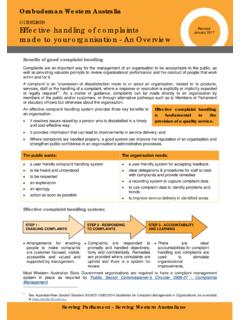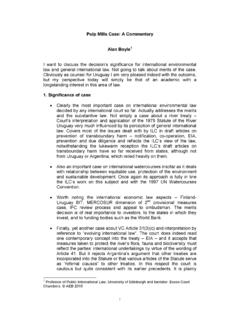Transcription of Basic Mediation Training TRAINERS’ MANUAL - …
1 Basic Mediation Training TRAINERS' MANUAL . Carol Orme-Johnson Mark Cason-Snow copyright Mediation @MIT 2002. CONDITIONS OF USE. This MANUAL is offered for use by accredited institutions of higher education in their campus Mediation programs. The underlying premise and purpose of its publication on the Web is to make materials used in the Mediation @MIT Basic Mediation Training freely and openly available to others for non-commercial educational purposes. MIT grants others the right to use the materials, either as-is, or in a modified form. Users may edit, translate, reformat, add to, or otherwise change this material, or combine it with or incorporate it into their own materials. However, there are three requirements that a user must meet as a condition of using the materials: Non-commercial. The use must be non-commercial. Attribution. Any and all use or reuse of the material, including use of derivative works (new materials that incorporate or draw on the original materials), must be attributed to Share alike.
2 Any publication or distribution of original or derivative works, including production of electronic or printed class materials or placement of materials on a web site, must offer the works freely and openly to others under the identical terms stated here. PREFACE. Many people have contributed to the creation of this MANUAL . Carol Orme- Johnson is the Director and Mark Cason-Snow the Assistant Director of Mediation @MIT, the peer Mediation program at Massachusetts Institute of Technology (MIT). Together they have taught the Basic Training in Mediation and numerous shorter classes in conflict resolution for seven years. Other major contributors to this work include Laura McDonald, co-founder with Orme- Johnson of Mediation @MIT, Mary Rowe, an expert in negotiation theory and Ombudsman at MIT for over twenty years, and Toni Robinson, Ombudsman at MIT (and mediator with the US Postal Service and consultant with ADR Options Consulting) and author of most of the section on multicultural issues.
3 Barbara Fienman provided editorial assistance. Numerous others have contributed ideas, criticisms, feedback, and help. This MANUAL is designed to be used with a Handbook for the participants and a video, "The Bench by the Wall". On request Mediation @MIT will sell one copy of the Handbook, and license to make up to 24 copies. The video is available for purchase from For more information contact We also recommend that all participants read Getting Past No, by Ury, and we discuss it in class. Note that the numbers in the left column of the MANUAL represent the number of minutes allotted for that section of the class, totaling 180 minutes per class. INTRODUCTION. This MANUAL is intended to serve as a guide for the trainer(s) leading a Basic Training in Mediation for participants with no prior Mediation experience. It reflects the style of Mediation and the style of teaching we use at the Massachusetts Institute of Technology (MIT). This version contains the changes and improvements we have made in Training over 250 faculty, staff, graduate students and undergraduates over the years.
4 The Mediation model we use in the peer Mediation program and teach in the Training utilizes two co-mediators and is somewhere between problem-solving and transformative in its approach. Mediation is totally voluntary and confidential. No one sends participants to Mediation and no one enforces the agreement. The parties must choose Mediation , or it will not happen, and chose to abide by their agreement (if one is reached). Mediators maintain complete confidentiality and parties are asked at the outset not to reveal anything said there. There is no official record of the agreement or indeed of the Mediation . We teach a formal Mediation process with co-mediators and then offer participants opportunities to practice using these skills in informal settings as well. The teaching style is highly experiential. The best way to learn to mediate is by doing it. Accordingly, participants spend approximately half of their time in role plays, and lectures are mixed with exercises.
5 Feedback from participants has reinforced the value of the role plays. Three themes recur throughout the lectures and role plays: party control, self awareness, and diversity. It has been our experience that most participants are not familiar with a dispute resolution process in which the parties themselves decide what issues to address and what the outcome will be. They must be taught to resist their impulse to fix or tell the parties how to fix their problems. We emphasize that a good mediator must be aware of, and therefore able to prevent interference from, his/her own approach to conflict, own sensitive issues, and own assumptions about others. Mediators' and parties' assumptions based on gender, race, religion or ethnic background and ignorance of others beliefs are particularly likely to impede the open communication so crucial to Mediation . We teach a western style of Mediation based on the belief that the way to resolve a dispute is to talk candidly about it.
6 The Training comprises eleven sessions, nine lasting three hours and two lasting four hours for a total of thirty-five hours. At MIT it is not offered for credit but is compressed into two weeks during our Independent Activities Period between semesters. Two trainers attend every class and divide the teaching load. We also have guest lecturers teach the diversity and negotiation theory classes, and mediators we have trained help as role play coaches. The five formal and four informal Mediation role plays allow opportunities for all participants to mediate two or three times and observe the process (as neither mediator nor party) once, as long as the groups do not exceed five people each. The quality of the role play experience will be significantly affected by the ability of the coach assigned to each group to identify and explain both mistakes and achievements. Limiting the class size to between twenty and twenty-five participants has the benefits of keeping down the number of coaches needed and allowing for the group to bond, which can be a very valuable experience.
7 Because this Training was created for a college setting, the subjects of the examples used in class and of the role plays are primarily drawn from campus life. The skills and insights acquired are, of course, equally valuable in non- academic settings. In fact, in every class at least one person reports that the Training has fundamentally changed his/her life. I hope you will enjoy leading Mediation Training as much as I do. Carol Orme-Johnson Mediation @M IT. Massachusetts Institute of Technology Cambridge, MA. December 2002. TABLE OF CONTENTS. Class Outline Overview .. 4. Session 1: Introduction & 5. Session 2: Communication Skills .. 9. Session 3: Mediation basics and Role Play # 21. Session 4: Negotiation Theory, Standard Intro., Role Play #2 .. 23. Session 5: The Mediation Process & 30. Session 6: Personal Approach to Conflict, Role Play # 34. Session 7: Tactics When Stuck, Role Play #4 .. 36. Session 8: Multicultural 39. Session 9: Transformative / Problem Solving, Role Play #5.
8 44. Session 10: Getting Past No, & Role Play #6A&B .. 47. Session 11: Questions, Role Plays #7A-B, Ethics, 49. APPENDIX OF HANDOUTS. Active Listening Self Assessment Informal Role Play Assignment Guidelines for Parties Certificate Guidelines for Coaches Final Evaluation Mediator Assessment Form Role Play Assignment Sheets The Flow of a Mediation Standard Introduction Personal Approach to Conflict Tactics When Stuck Exercise Mid- Training Evaluation Transformative v. Problem Solv'g SEE PART TWO FOR ROLE PLAY SCENARIOS. Demonstration: Lisa & Henry Formal: #1 Delta Delta & The Sisters #2 Lee & Ricky #3 Sherron & Taiwo #4 Annie & Janet #5 Carl & Louis Informal: #6A Terry & Yuen #6B Walker & Quick #7A Linda & Bob #7B Claudia & Sunil SEE PART TWO FOR SLIDES. SUBJECT CONTENT. 1. Conflict Resolution Styles List of 5 principal styles 2. Active Listening Listening Skills 3. Active Listening #1 Listening is Important and Powerful 4. Active Listening #2 What's Active About It?
9 5. Active Listening #3 3 Ways of Looking at AL. 6. Active Listening #4 Active Listening Skills 7. Active Listening #5 Get the Story 8. Active Listening #7 Probe / Clarify Meanings 9. Active Listening #8 Listen for (and Respond to) Emotions 10. Active Listening #9 Summarize 11. Active Listening #10 Value Silence 12. Uses of Active Listening Goals & Challenges in Mediation 13. Active Listening Exercise #1 Scenario 1. 14. Active Listening Exercise #2 Scenario 2. 15. Reframing in Mediation Goals of reframing 16. Reframing Strategies #1 De-escalating and calming 17. Reframing Strategies #2 Moving from positions to interests 18. Reframing Strategies #3 Turning concerns into solvable problems 19. Reframing Strategies #4 Developing shared goals or trade-offs 20. Reframing Batting Practice Exercise for group practice 21. The Flow of a Mediation Description of early stages in the process 22. The Flow of a Mediation Description of later stages in the process 23.
10 Pronouns Use of language in Mediation 24. Negotiation Styles Graphic representation of distributive conflict resolution styles 25. Negotiation Styles Graphic representation of distributive conflict resolution styles, plus collaboration 26. Preparing for Negotiation List of tasks for Distributive Negotiation 27. Preparing for Negotiation List of tasks for Integrative Negotiation 28. Preparing for Negotiation List of tasks for Mediation 29. Sources of Power Perceived power in a negotiation 30. Groundrules Avoiding Pitfalls and Handling Options 31. Types of Agreement Narrowing the focus from general to specific 32. Mediator's Role: Overview Structuring the process 33. Mediator's Role #2 Channeling communication 34. Mediator's Role #3 Reality check 35. Mediator's Role #4 Brainstorming & generating options 36. Mediator's Role #5 Creating opportunities for understanding 37. Mediator's Role #6 Noticing the signposts 38. Style as Strategy Turning a style into a strategy, w/ examples 39.



